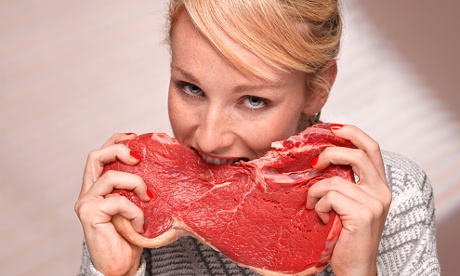
Anyone who has ever wondered how Wall Street affects our lives need only look at the unfortunate case of price-tag trickery among grocers.
As beef prices have risen, grocers are relying on a little illusion to keep consumers in the dark. Instead of pricing meat by the pound, some are pricing it by the piece.
“When you to go the meat counter and say, ‘Wow, that steak’s only $3.99.’ But it’s not a pound. It’s eight ounces,” says John Kleist, lead agricultural hedge strategist, eBOTTrading.com, a brokerage and research firm.
The reason steak dinners aren’t getting any cheaper: livestock markets, including cattle and hogs, have seen significant increases in prices, and consumers are feeling the pinch.
There are, to put it simply, fewer animals to eat. During 2014 herd sizes for cattle and hogs were down versus the previous year, and chicken flocks were also lower. It’s an unusual occurrence for all three to have smaller numbers, said analysts at Urner Barry, a firm that closely follows protein prices.
That led to record-high futures prices for cattle and hogs, which translated to high prices at the supermarket meat counter. The good news for carnivores is that meat prices are dropping; the bad news is that it will take some time for consumers to see smaller food bills, livestock analysts said.
Hog and pork prices were the first to fall, and livestock analysts said there are signs soaring prices for cattle and beef are also in the rearview mirror.
The reason for that is the life cycle of the animals. Chickens can grow from hatchlings to full-size birds in as little as four to six weeks.
However, it takes about four to six months to bring a hog to slaughter weight, not including gestation time, and for cattle it can take up to 30 months.
For 2015, the US Department of Agriculture forecasts higher chicken and hog production.
There will be a small increase in 2015 bovine numbers as ranchers rebuild cattle herds, but it may be 2017 before cattle numbers have risen appreciably, Urner Barry said.
The origins of the record-high cattle prices lie in ethanol and the 2013 Midwestern drought. Cattlemen compete with ethanol producers for corn. A shriveled US corn crop in 2013 intensified that rivarly and sent grain prices to unprecedented levels. The drought also baked pastures, which is where cattle spend most of their lives.
Unable to profitably feed the animals, ranchers culled them, which caused the herd size to shrink to its smallest tally since 1951 in 2014.
Hog production slid in 2013 and into the first quarter of 2014, caused by losses from the highly infectious porcine epidemic diarrhea virus known as PEDv. Infected older pigs at a minimum lose weight, and the disease is usually fatal to piglets. It doesn’t affect humans or meat quality.
But as producers started to better control PEDv, hog futures and wholesale pork prices fell. This year’s drop in corn prices because of a record harvest encouraged producers to, well, pig out.
“They’ve overfed them to the point we’ve been running record-high hog weights for the past couple of months. That’s a lot of pork tonnage. The kills [number of hogs slaughtered] are under a year ago, but the total pork is making up for the decline in kills. That’s a big consideration as far as supplies are concerned,” said Kleist.
Hog futures prices at the Chicago Mercantile Exchange lost about 6% in 2014, despite hitting record highs in July.
Live cattle futures still ended 2014 with 20% gains, but were down about 5% from their record high.
Late December saw cattle futures and beef prices rise again, but Kleist said that’s likely a temporary phenomenon stemming from ranchers holding back sales for tax purposes, and not wanting to transport cattle during a severe cold snap, along with a rise in high-end-beef demand for New Year’s dinners.
He noted that futures markets are suggesting prices will fall again.
Ken Morrison, editor of the Morrison on the Markets newsletter, also cited the lower deferred-futures prices. The ebb in rising cattle numbers will eventually become a slump, and beef prices will slump in the latter half of 2015, he said.
Meatpackers have been losing money for a few months now, he said, so it “adds to the resistance to pay up in an environment when the people in the business are losing money slaughtering cattle.”
So what does all of this mean for dinner?
Morrison said at the very least lower pork and chicken prices will likely cap beef prices at the wholesale level.
At the retail level, it all depends.
Kleist said wholesale pork prices have been down since mid-year 2014, but grocers haven’t passed on the savings to shoppers. They’ve kept pork prices higher to offset the losses they incur when selling beef.
To push beef, grocers also priced it as per piece, rather than per pound.
Significant drops won’t likely be seen until mid-summer at the earliest, Kleist said. That’s when slightly more beef will sit on store shelves. It might be 2016 before slinging burgers gets really cheap again.
But don’t cry for the carnivore. With a lot more hogs and chickens expected to be running around in 2015, “there will be plenty of choice for the consumer,” Morrison said.

